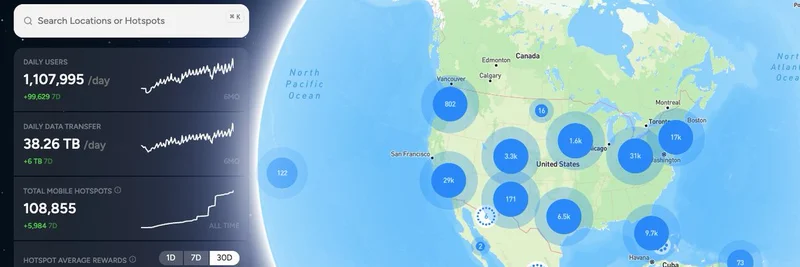In the fast-paced world of blockchain, where hype often trumps real-world utility, Helium is quietly proving that building a decentralized wireless network can drive massive adoption. A recent tweet from Ariel Seidman, CEO and co-founder of BeeMaps and founder of Hivemapper, highlighted a striking fact: Helium boasts more daily active monetized users than some layer-1 (L1) blockchains with valuations orders of magnitude higher. This isn't just another crypto boast—it's backed by solid metrics that show Helium's people-powered network hitting over 1 million daily users and more than 108,000 mobile hotspots.
Seidman was quoting an update from the official Helium account, which shared a snapshot of their dashboard. For those new to Helium, it's a decentralized physical infrastructure network (DePIN) built on Solana, where users deploy hotspots to provide wireless coverage for IoT devices and mobile data, earning HNT tokens in return. Think of it as Airbnb for wireless networks—anyone can contribute and get paid.
The dashboard reveals impressive growth: 1,107,995 daily users (up nearly 100,000 from the previous period), 38.26 TB of daily data transfer, and hotspot average rewards around $33.40. These aren't just vanity numbers; they represent real people connecting to the network, either intentionally subscribing or through carrier offloading, as Seidman clarified in a reply. Both types are monetized, meaning hotspot owners earn from the activity.
Now, let's put this in perspective. Major L1 blockchains like Ethereum and Bitcoin, with market caps in the hundreds of billions, often report daily active addresses (a proxy for users) in the hundreds of thousands. Recent data from early 2025 shows Ethereum averaging about 234,000 daily active addresses, Bitcoin around 383,000, while Solana leads with over 3 million. Helium's 1M+ daily users put it ahead of Ethereum and Bitcoin in this metric, yet HNT's market cap hovers around $500 million—peanuts compared to Ethereum's $280 billion or Solana's $70 billion.
Why the disparity? Seidman nails it: Helium is delivering tangible utility in the real world, powering wireless connectivity without the massive VC-backed hype that inflates some L1 valuations. It's a reminder that in crypto, adoption doesn't always align with price. As one reply pointed out, "Adoption metrics vs. VC valuations. The eternal struggle. Eventually, reality catches up." Questions about why HNT hasn't pumped in line with growth highlight a common crypto puzzle—great fundamentals don't always mean immediate gains.
The tweet also stirred up the meme token crowd, with replies tying it to playful ideas like "Dogstock L1 when?" (complete with a fun animated video of meme dogs playing cards, hinting at a dog-themed layer-1 blockchain) and promotions for projects like MemeGames.ai, which turns crypto trading into a game. It's fascinating how a serious DePIN discussion sparks meme energy—perhaps because Helium's community-driven model resonates with the decentralized ethos of meme tokens. After all, both thrive on grassroots participation, whether it's deploying hotspots or rallying around a fun narrative.
For blockchain practitioners eyeing meme tokens or DePIN plays, Helium's story is a goldmine. It shows how building infrastructure with real monetization can outpace speculative L1s in user engagement. If you're into Solana ecosystem projects, keep an eye on HNT—its integration means seamless scalability, and with telecom giants like AT&T offloading traffic to Helium, the network's growth could accelerate.
Curious about diving in? Check out the Helium Explorer for live stats or grab a hotspot to start earning. As the crypto space evolves, projects like Helium remind us that true value comes from solving real problems, not just riding market waves. What do you think—will Helium's user base push HNT to new heights? Drop your thoughts below.



